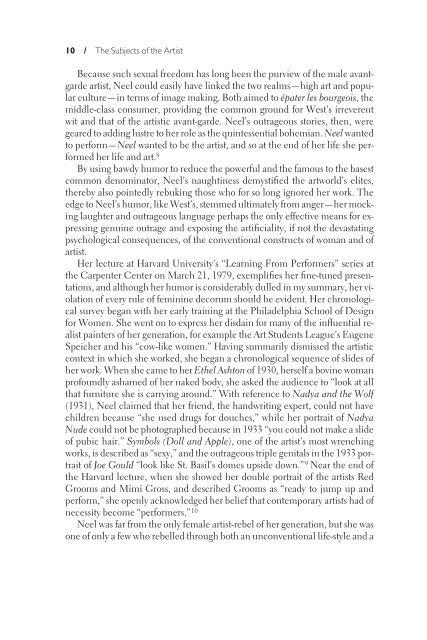i-xxii Front matter.qxd - Brandeis Institutional Repository
i-xxii Front matter.qxd - Brandeis Institutional Repository
i-xxii Front matter.qxd - Brandeis Institutional Repository
You also want an ePaper? Increase the reach of your titles
YUMPU automatically turns print PDFs into web optimized ePapers that Google loves.
10 / The Subjects of the ArtistBecause such sexual freedom has long been the purview of the male avantgardeartist, Neel could easily have linked the two realms—high art and popularculture—in terms of image making. Both aimed to épater les bourgeois, themiddle-class consumer, providing the common ground for West’s irreverentwit and that of the artistic avant-garde. Neel’s outrageous stories, then, weregeared to adding lustre to her role as the quintessential bohemian. Neel wantedto perform—Neel wanted to be the artist, and so at the end of her life she performedher life and art. 8By using bawdy humor to reduce the powerful and the famous to the basestcommon denominator, Neel’s naughtiness demystiƒed the artworld’s elites,thereby also pointedly rebuking those who for so long ignored her work. Theedge to Neel’s humor, like West’s, stemmed ultimately from anger—her mockinglaughter and outrageous language perhaps the only effective means for expressinggenuine outrage and exposing the artiƒciality, if not the devastatingpsychological consequences, of the conventional constructs of woman and ofartist.Her lecture at Harvard University’s “Learning From Performers” series atthe Carpenter Center on March 21, 1979, exempliƒes her ƒne-tuned presentations,and although her humor is considerably dulled in my summary, her violationof every rule of feminine decorum should be evident. Her chronologicalsurvey began with her early training at the Philadelphia School of Designfor Women. She went on to express her disdain for many of the in„uential realistpainters of her generation, for example the Art Students League’s EugeneSpeicher and his “cow-like women.” Having summarily dismissed the artisticcontext in which she worked, she began a chronological sequence of slides ofher work. When she came to her Ethel Ashton of 1930, herself a bovine womanprofoundly ashamed of her naked body, she asked the audience to “look at allthat furniture she is carrying around.” With reference to Nadya and the Wolf(1931), Neel claimed that her friend, the handwriting expert, could not havechildren because “she used drugs for douches,” while her portrait of NadyaNude could not be photographed because in 1933 “you could not make a slideof pubic hair.” Symbols (Doll and Apple), one of the artist’s most wrenchingworks, is described as “sexy,” and the outrageous triple genitals in the 1933 portraitof Joe Gould “look like St. Basil’s domes upside down.” 9 Near the end ofthe Harvard lecture, when she showed her double portrait of the artists RedGrooms and Mimi Gross, and described Grooms as “ready to jump up andperform,” she openly acknowledged her belief that contemporary artists had ofnecessity become “performers.” 10Neel was far from the only female artist-rebel of her generation, but she wasone of only a few who rebelled through both an unconventional life-style and a
















